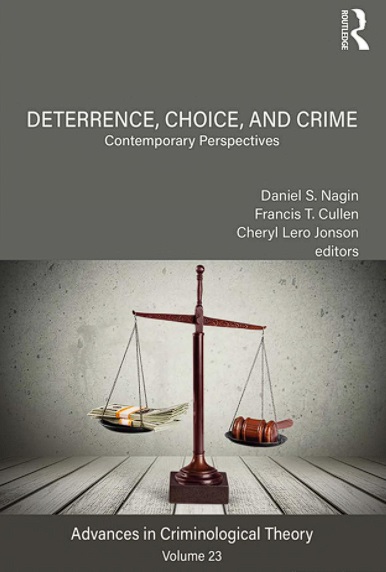The criminal justice system is the institution which is present in every advanced country, and it is responsible for punishing individuals for their wrongdoings. Nevertheless, in the United States, the criminal justice system gave rise to the prison-industrial complex. The term is used by critics for describing the intertwined interests of governments and businesses in the sphere of policing and incarceration.
Summary
The chapter titled “Deviance” in the book “The Real World: Introduction to Sociology” provides an insight into the aforementioned phenomena of The Criminal Justice System and the Prison-Industrial Complex. The concept of deterrence is fundamental for the current criminal laws and the punishment intended for perpetrators. Some theorists claim that severe punishments can deter people from committing crimes since they will not be ready to accept the repercussions (Ferris and Stein 2018). One of the most notable laws here is the “three strikes” law in California which converts three felonies to a life sentence. Nevertheless, in sociology, the link between the benefits of the crime and the cost of the punishment is rarely observed.
There are other types of justifications for punishments for crime, for instance, retribution, which means that society has the right to inflict the same damage to the criminal as they did to society. While the notion of incapacitation involves confining or executing perpetrators to ensure society’s security, at the same time, there is an idea that society should focus on rehabilitation instead of punishment. In other words, the entire prison system must aim at reforming the inmates and helping them refrain from crime in the future.
In the United States, the criminal justice system is an institution which involves local, state, and federal governments which are tasked with law-making together with the penitentiary system, courts, and the police. Since any institution reflects its own society, the U.S. criminal justice system delivers benefits to the population and simultaneously has many deficiencies. According to some experts, there is a “youth control complex” which comprises the judicial system, law enforcement, and schools which tend to “criminalize” working-class youth (Ferris and Stein 2018:170). The current system is particularly discriminatory towards ethnic minorities, and especially African Americans who are often falsely convicted to large sentences. Unlike the U.S. prisons, which are often overcrowded, violent, and focus on retribution, Scandinavian penitentiaries are dormitory-like and provide criminals with a chance to rehabilitate themselves and become contributing members of society.
The Prison-Industrial Complex is a phenomenon which is inherent to the U.S. criminal justice system and reflects the current corrections trends. Essentially, the term describes the presence of privately-owned penitentiaries, which are for-profit organizations receiving subsidies from the government. The problem with such establishments is their constant stress on cost-saving and desire to earn more which translates into unpaid labor for inmates and a lack of education spending. “When prisons become businesses, they become more focused on their bottom line… than rehabilitating their prisoners” (Ferris and Stein 2018:172). The rate of prison privatizations has been growing for the past several decades, which also coincides with the increasing number of inmates. Thus, such developments cause critics to become concerned about the effectiveness of such a system and become doubtful about its future.
Response
The primary reason why there are severe sentences for crimes and difficult prison conditions in the United States is the fact that deterrence and incapacitation are the main rules governing the current criminal law-making. Yet, the question arises concerning the effectiveness of such an approach in terms of future crime and the dynamics of the size of the prison population. According to research, there is no evidence which would support the notion that the severity of punishment can prevent crime, instead, there is data which shows that crime is responsive to labor-market opportunities (Chalfin and McCrary 2017). In other words, the current approach cannot be considered effective from the scientific perspective, and there are other studies which prove it. Another research demonstrated that the certainty of apprehension was the primary factor contributing to deterrence and not the severity of the legal ramifications (Nagin et al. 2018). Thus, the information provided in the chapter in question is correct since it clearly states that there is no causal link between punishment and crime and its benefits.
As a result, it is important to see whether the rehabilitation approach constitutes a better alternative to the current U.S. penal system and whether it can yield positive effects. One study explored the impact of social rehabilitation programs on incarcerated individuals and found that participation in such activities can reduce the recidivism rate (Lotti 2020). While prisons with harsh conditions demonstrate higher rates of recidivism among their inmates after their release. Such evidence shows that rehabilitation can be a viable strategy for the U.S. penal system, and there are other studies with similar results. For instance, research demonstrates that practices such as yoga and transcendental meditation programs can significantly decrease the rate of recidivism among inmates (Derlic 2020). Thus, it is possible to assume that the rehabilitation methods can ultimately have a positive impact on the behavior of criminals stimulating them to begin a new life free of crime. Moreover, there can be a variety of different rehabilitation interventions which can incentivize inmates to stop committing crimes.
Private prisons play a major role in the prison-industrial complex in the United States, but the book’s chapter mentioned that they get a lot of criticism. Nevertheless, the question of their effectiveness still remains, and it possible that they are better than public penitentiaries. Existing research shows that private for-profit facilities can be more cost-effective than state and county ones but at the same time were less effective in terms of recidivism (Kim 2019). Such evidence means that for-profit private prisons can benefit society in terms of cost-cutting but ultimately harm it since the number of criminals is not going down. Thus, the criticism presented in the chapter is justified because cost-reduction negatively affects inmates’ conditions.
Opinion
It is clear that deterrence through increased severity of punishments does not lead to a reduction in terms of recidivism. Nevertheless, the notion of retribution is still an essential element of the criminal justice system which cannot be measured but has psychological importance. In other words, people are used to the idea that an individual who commits a crime always receives a punishment which can be comparable to what they did. In this case, the relatives of victims are usually the main party who is interested in giving a harsh sentence to the criminal. It would not be morally right to lessen the severity of punishments for certain crimes such as murder simply because they do not stop people from engaging in them. As a result, governments must not reform the justice system in terms of the punishments and laws such as the “three-strike” one must continue to exist because they ensure proper retribution for wrongdoings.
Nevertheless, there is no doubt that the current justice system must be reformed in other areas, namely policing, courts, and the penal system. Recent events related to the death of George Floyd once again exposed the deficiencies which exist in the U.S. criminal justice system. Police violence is one of the key issues which society is currently facing and especially the one which is targeted at racial minorities. Moreover, African Americans are disproportionately represented among prison populations, and one in four Black men get incarcerated in their life (Kovera 2019). Such statistics constitute evidence that the American criminal justice system has considerable problems with its treatment of racial minorities. Rehabilitation must be one of the key areas of focus in the process of reforming the system. The research presented above demonstrates that rehabilitation interventions are effective in reducing the recidivism rate. Thus, the government must work on developing appropriate laws which would introduce rehabilitation to all penal facilities in the country.
Rehabilitation is closely connected with the prison-industrial complex and commercialization of the penitentiary system, which is rapidly growing in the United States. As the aforementioned evidence from research demonstrated, for-profit facilities can bring down costs but are ineffective in terms of the decrease in recidivism. Moreover, private prisons may actually be interested in increasing the rate of recidivism since, thus, they will always have inmates ensuring a stable inflow of subsidies. Nevertheless, if states decide to keep private prisons, they should not focus on cost-cutting and must make rehabilitation their priority. It is possible that rehabilitation programs will involve utilizing more resources, but if such interventions prove to be effective, society will benefit from a lower rate of recidivism. Thus, issues inherent to the prison-industrial complex can be resolved only if the federal and state governments take proper actions to reduce recidivism.
Conclusion
The United States must focus its efforts on rehabilitation as a key part of its penal system. Ultimately, such actions will lead to a decrease in recidivism and a safer society. As a result, the country will be able to improve its criminal justice system.
References
Chalfin, Aaron, and Justin McCrary. 2017. “Criminal Deterrence: A Review of the Literature.” Journal of Economic Literature. 55(1): 5-48.
Derlic, Dragana. 2020. “A Systematic Review of Literature: Alternative Offender Rehabilitation—Prison Yoga, Mindfulness, and Meditation.” The Journal of Correctional Health Care. 26(4): 361-375.
Ferris, Kerry, and Jill Stein. 2018. “Chapter 6: Deviance.” Pp. 155-175 in The Real World: Introduction to Sociology. 6th ed., edited by Ferris, K., and J. Stein. New York: W.W. Norton.
Kim, Dae-Young. 2019. “Prison Privatization: An Empirical Literature Review and Path Forward.” International Criminal Justice Review, 29 (3): 1-24.
Kovera, Margaret Bull. 2019. “Racial Disparities in the Criminal Justice System: Prevalence, Causes, and a Search for Solutions.” The Journal of Social Issues. 75(4): 1139-1164.
Lotti, Giulia. 2020. “Tough on Young Offenders: Harmful or Helpful?” The Journal of Human Resources. 56(2): 53-68.
Nagin, Daniel S., Francis T. Cullen, and Cheryl Jonson. 2018. Deterrence, Choice, and Crime. New York: Routledge.
Appendix A
Chalfin, Aaron, and Justin McCrary. 2017. “Criminal Deterrence: A Review of the Literature.” Journal of Economic Literature. 55(1): 5-48.
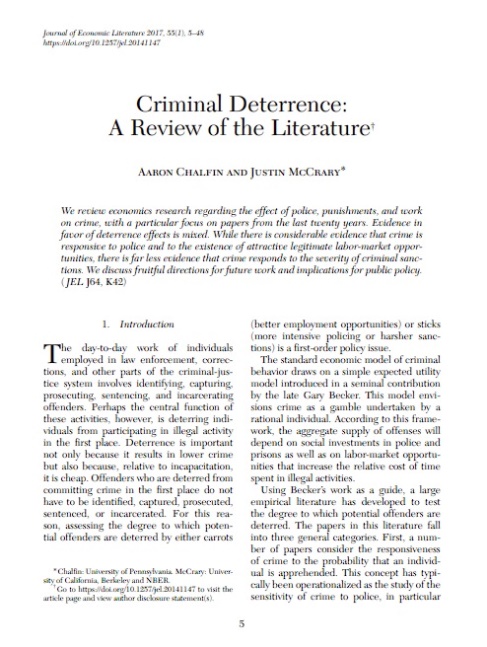
Derlic, Dragana. 2020. “A Systematic Review of Literature: Alternative Offender Rehabilitation—Prison Yoga, Mindfulness, and Meditation.” The Journal of Correctional Health Care. 26(4): 361-375.
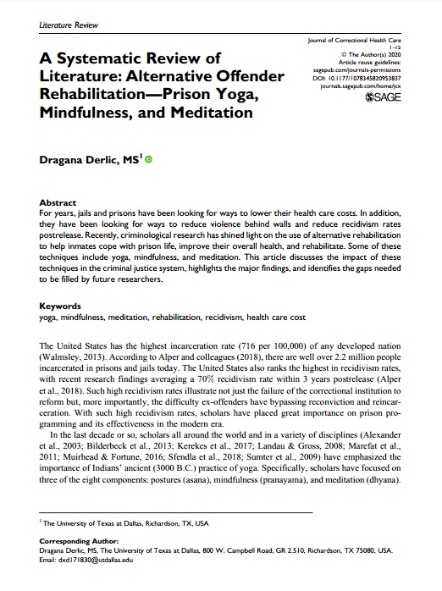
Ferris, Kerry, and Jill Stein. 2018. “Chapter 6: Deviance.” Pp. 155-175 in The Real World: Introduction to Sociology. 6th ed., edited by Ferris, K., and J. Stein. New York: W.W. Norton.

Kim, Dae-Young. 2019. “Prison Privatization: An Empirical Literature Review and Path Forward.” International Criminal Justice Review, 29 (3): 1-24.
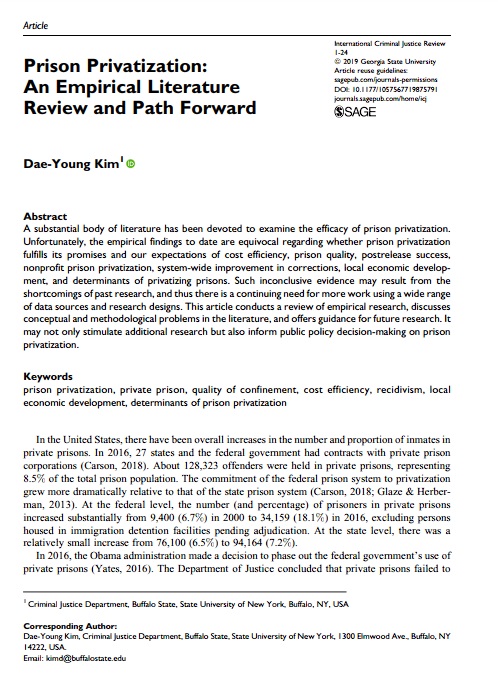
Kovera, Margaret Bull. 2019. “Racial Disparities in the Criminal Justice System: Prevalence, Causes, and a Search for Solutions.” The Journal of Social Issues. 75(4): 1139-1164.
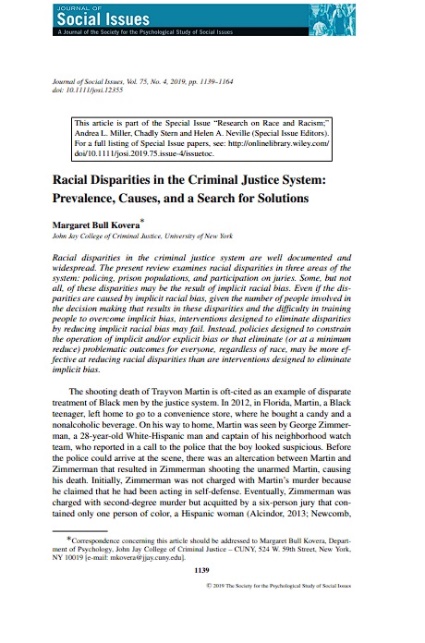
Lotti, Giulia. 2020. “Tough on Young Offenders: Harmful or Helpful?” The Journal of Human Resources. 56(2): 53-68.
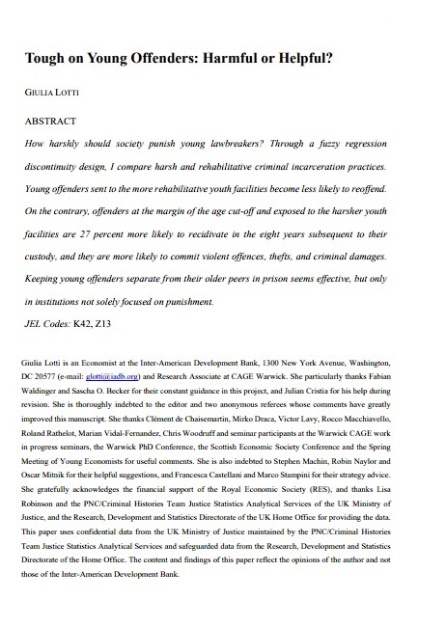
Nagin, Daniel S., Francis T. Cullen, and Cheryl Jonson. 2018. Deterrence, Choice, and Crime. New York: Routledge.
